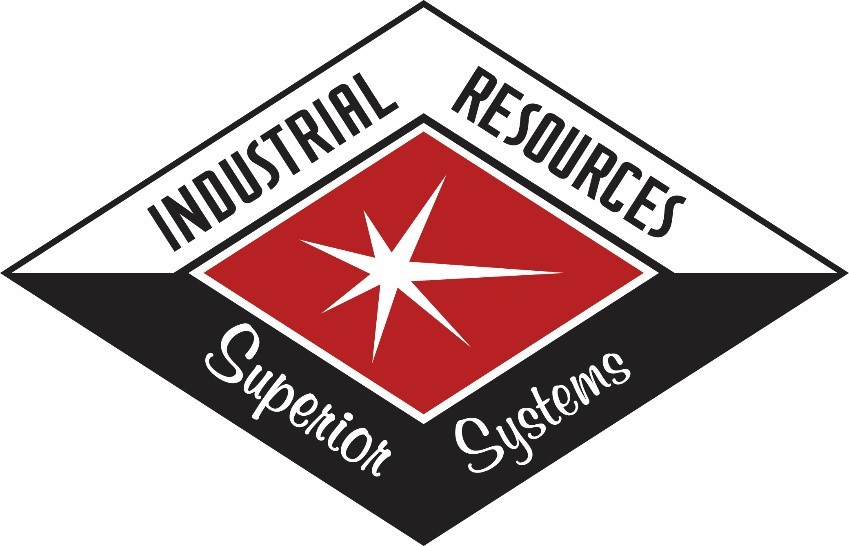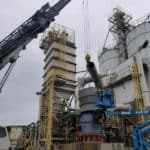IRI Meets IKO Timeline and Safety Challenges Head-On
In late 2019, IKO hired Industrial Resources to replace a 92-year-old crusher used in asphalt roof shingle production at its mill in Sumas, Washington. IKO is one of the world’s largest manufacturers of asphalt roof shingles. The company exports to 96 countries from 25 plants in 7 countries around the globe.
Crusher history: flour production
The 25 Ton crusher was built and commissioned in 1927. Originally, it was used to crush wheat on a midwestern farm. Years later, the wheat mill closed, and a third party purchased, refurbished, then sold the crusher to IKO in 1998.
IKO shipped the crusher to Sumas Washington and installed it at its new mill, which opened in 1999. The addition of a crusher enabled the mill to expand its capabilities by adding a 3-tab asphalt shingle product line.
 What does a crusher do?
What does a crusher do?
The crusher’s job is to crush limestone into a fine baby-powder-like filler. IKO adds the lime filler to asphalt before applying it as a topcoat to its roof shingles. The filler acts to increase the surface tackiness of the shingles while also giving them a broader tolerance to temperature.
The crusher was built to last using a combination of forged and cast steel (also containing manganese). However, as bearings, rollers, and as casings wore out, they became increasingly difficult and expensive to replace. IKO site staff determined the time had come to replace the old crusher with a new model.

Project goals made clear
When IKO hired IRI to replace the crusher, the goal was clear: Achieve zero downtime. To support this, IKO stockpiled a three-week supply of crushed limestone filler. But when the filler ran out, the new crusher needed to be fully functional. If not, IKO would fall behind in manufacturing orders. IRI had three weeks to complete the project. Not a day more.
Managing tight production-driven schedules is one of IRI’s core strengths. With an experienced crew, a senior project manager, and motivated apprentices, the team tackled the project head-on.
Scope of work
The first order of business was to remove the old crusher using a 90-ton mobile crane. IRI crew strategically prepped, rigged, and lifted the old crusher in three days with only four crane picks.
Next, IRI hired RCI, Inc. to build a frame, pour and cure a foundation slab for the new crusher. The 14 person IRI crew spent the following nine days building a new structure and installing the new crusher.
 One of the biggest challenges was completing all the customized ductwork, which had to be fabricated and installed not only on-site but in place. Fabricators worked at varying heights on the same structure at the same time.
One of the biggest challenges was completing all the customized ductwork, which had to be fabricated and installed not only on-site but in place. Fabricators worked at varying heights on the same structure at the same time.
We had zero incidents and zero near-misses
“When you have that many people working on top of each other, the only thing that ensures the project gets done safely is making communication the top priority,” said Andy West, IRI Project Manager. “We can proudly say we had zero incidents and zero near-misses.”
West explained that every morning started with a toolbox talk. “It takes good communication and experienced craftsmen to pull off a project like this,” said West. “All tasks and scope changes require Job Safety Analysis or JSA. A JSA must be signed-off by everyone on the job site to ensure all workers are on the same page.” West shared that a major crane pick, for example, or even a change in weather or temperature, could trigger the need for a JSA.
The moment of truth
The construction was completed in 18 days: 3 days ahead of schedule. The moment had come to put the system to the test. “It was one of those moments when you’re crossing your fingers,” said West. “When the unit turned on, we felt vibrations like we’d never felt before. To see and hear this unit do its job, was pretty awesome.”
In the end, IRI’s attention to detail paid off. All structures, ductwork, ladders, and catwalks were perfectly aligned and secure, allowing the mill to operate at full capacity right on schedule.
















